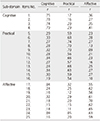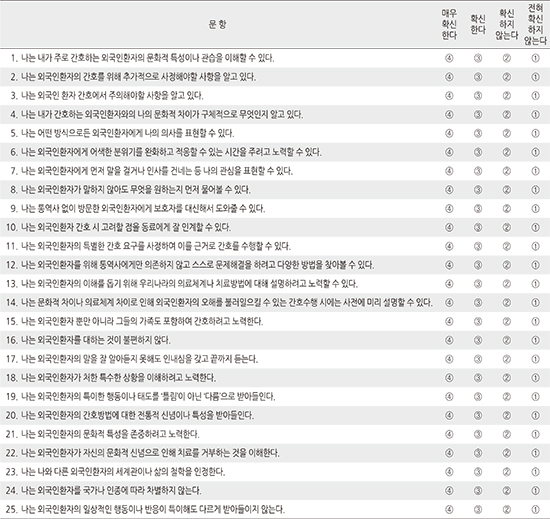This article has been corrected. See "Corrigendum: Development and Psychometric Evaluation of the Transcultural Self-efficacy Scale for Nurses" in Volume 46 on page 766.
Abstract
Purpose
This methodological study was conducted to develop and psychometrically test the Transcultural Self-efficacy scale (TCSEscale) for nurses.
Methods
Initial 41 items for the TCSE-scale were generated based on extensive literature reviews and in-depth interviews with 18 nurses who had experience in caring for foreign patients. Cultural Competence and Confidence model was used as a conceptual framework. Content validity was evaluated by an expert panel. Psychometric testing was performed with a convenience sample of 242 nurses recruited from four general hospitals in the Seoul metropolitan area and Gyeonggi-do province of South Korea. To evaluate the reliability of TCSE-scale, a test-retest reliability and an internal consistency reliability were analyzed. Construct validity, concurrent validity, criterion validity, convergent validity and discriminative validity were used to evaluate the validity.
Results
The 25-item TCSE-scale was found to have three subscales-Cognitive, Practical, and Affective domain-explaining 91.5% of the total variance. TCSE-scale also demonstrated a concurrent validity with the Cultural Competence Scale. Criterion-related validity was supported by known-group comparison. Reliability analysis showed an acceptable-to-high Cronbach's alpha-.88 in total, and subscales ranged from .76 to .87. The ICC was .90, indicating that the TCSE-scale has internal consistency and stability of reliability.
Conclusion
This preliminary evaluation of the psychometric scale properties demonstrated an acceptable validity and reliability. The TCSE-scale is able to contribute to building up empirical and evidence based on data collection regarding the transcultural self-efficacy of clinical nurses. We suggest further testing of the applicability of TCSE-scale in different settings and community contexts.
References
1. Statistics Korea. Vital statistics 2014 [Internet]. Daejeon: Author;2015. cited 2015 October 13. Available from: http://meta.narastat.kr/metasvc/svc/SvcMetaDcDtaPopup.do?confmNo=10103&inputYear=2014.
2. National Archives of Korea. Multicultural family policy basics plan [Internet]. Daejeon: Author;2014. cited 2015 July 22. Available from: http://archives.go.kr/next/search/listSubjectDescription.do?id=009210.
3. Statistics Korea. 2014 foreigner labour force survey [Internet]. Daejeon: Author;2014. cited 2014 October 23. Available from: http://kostat.go.kr/portal/korea/kor_ko/5/2/index.board?bmode=read&aSeq=331368.
4. Ministry of Health and Welfare, Korea Health Industry Development Institute. Result of attract foreign patients [Internet]. Sejong: Ministry of Health and Welfare;2014. cited 2015 June 15. Available from: http://www.google.co.kr/url?url=http://download.mohw.go.kr/front_new/modules/download.jsp%3FBOARD_ID%3D140%26CONT_SEQ%3D300750%26FILE_SEQ%3D154218&rct=j&frm=1&q=&esrc=s&sa=U&ved=0ahUKEwjUvZvGytn-LAhWjF6YKHXxVBYoQFggZMAE&usg=AFQjCNEAL-BTY17-ouXy-sS0e8OV45nyhgQ.
5. Maurer FA, Smith CM. Community/public health nursing practice: Health for families and populations. 4th ed. St. Louis, MO: Saunders;2009.
6. Giger JN, Davidhizar R. Culturally competent care: Emphasis on understanding the people of Afghanistan, Afghanistan Americans, and Islamic culture and religion. Int Nurs Rev. 2002; 49(2):79–86. DOI: 10.1046/j.1466-7657.2002.00118.x.
7. Leininger M, McFarland MR. Transcultural nursing: Concepts, theories, research, and practice. 3rd ed. New York, NY: McGraw-Hill Education;2002.
8. Majumdar B, Browne G, Roberts J, Carpio B. Effects of cultural sensitivity training on health care provider attitudes and patient outcomes. J Nurs Scholarsh. 2004; 36(2):161–166. DOI: 10.1111/j.1547-5069.2004.04029.x.
9. Jeffreys MR. Development and psychometric evaluation of the transcultural self-efficacy tool: A synthesis of findings. J Transcult Nurs. 2000; 11(2):127–136. DOI: 10.1177/104365960001100207.
10. Jeffreys MR, Dogan E. Factor analysis of the transcultural selfefficacy tool (TSET). J Nurs Meas. 2010; 18(2):120–139. DOI: 10.1891/1061-3749.18.2.120.
11. Andrews MM, Boyle JS. Transcultural concepts in nursing care. 4th ed. Philadelphia, PA: Lippincott Williams & Wilkins;2002.
12. Bernal H, Froman R. The confidence of community health nurses in caring for ethnically diverse populations. Image J Nurs Sch. 1987; 19(4):201–203. DOI: 10.1111/j.1547-5069.1987.tb00008.x.
13. Park JH, Rho SH. Development and validation of an early childhood teacher multicultural efficacy scale. Korean J Early Child Educ. 2013; 33(5):237–256.
14. Polit DF, Beck CT, Owen SV. Is the CVI an acceptable indicator of content validity? Appraisal and recommendations. Res Nurs Health. 2007; 30(4):459–467. DOI: 10.1002/nur.20199.
15. DeVellis RF. Scale development: Theory and application. 3rd ed. Thousand Oaks, CA: Sage;2012.
16. Tinsley HE, Tinsley DJ. Uses of factor analysis in counseling psychology research. J Couns Psychol. 1987; 34(4):414–424. DOI: 10.1037/0022-0167.34.4.414.
17. Chae DH, Lee CY. Development and psychometric evaluation of the Korean version of the cultural competence scale for clinical nurses. Asian Nurs Res. 2014; 8(4):305–312. DOI: 10.1016/j.anr.2014.06.004.
18. Ferketich S. Focus on psychometrics. Aspects of item analysis. Res Nurs Health. 1991; 14(2):165–168. DOI: 10.1002/nur.4770140211.
19. Lee EO, Lim NY, Park HA, Lee IS, Kim JI, Bae J, et al. Nursing research and statistics. Paju: Soomoonsa;2009.
20. Lee JG. SAS and statistical data analysis. Seoul: Hakjisa corp.;2001.
21. Kim BJ, Chae SI. Statistic anaysis using SPSS PC+. Seoul: Bobmunsa Co.;1988.
22. Ware JE, Snow KK, Kosinski M, Gandek B. SF-36 health survey: Manual and institute. Boston, MA: The Health Institute, New England Medical Center;1993.
23. Landis JR, Koch GG. The measurement of observer agreement for categorical data. Biometrics. 1977; 33(1):159–174. DOI: 10.2307/2529310.
24. Atkinson G, Nevill AM. Statistical methods for assessing measurement error (reliability) in variables relevant to sports medicine. Sports Med. 1998; 26(4):217–238. DOI: 10.2165%2F00007256-199826040-00002.
25. Campinha-Bacote J. The process of cultural competence in the delivery of healthcare services: A model of care. J Transcult Nurs. 2002; 13(3):181–184. DOI: 10.1177/10459602013003003.
26. Xu Y. Give and take in cross-cultural consulting. Home Health Care Manag Pract. 2006; 18(3):255–257. DOI: 10.1177/1084822305284039.
27. Munoz C, Luckmann J. Transcultural communication in nursing. 2nd ed. Clifton Park, NY: Delmar Learning;2005.
28. Oh WO, Jung WS, Knag HG, Kim EH, Suk MH. Cultural knowledge, empathy and cultural sensitivity of university students majoring in health and welfare. J Korean Soc Sch Health. 2010; 23(2):192–199.
29. Lee K, Shin S. Validity of instrument development research in Korean nursing research. J Korean Acad Nurs. 2013; 43(6):697–703. DOI: 10.4040/jkan.2013.43.6.697.
30. Lee R, Kim SH, Lee KS, Seo MK. Development and validation of self-efficacy scale for self-management of breast cancer (SESSM-B). J Korean Acad Nurs. 2012; 42(3):385–395. DOI: 10.4040/jkan.2012.42.3.385.




 PDF
PDF ePub
ePub Citation
Citation Print
Print









 XML Download
XML Download